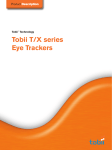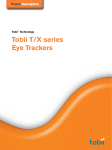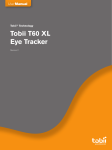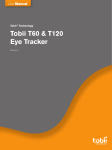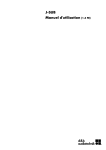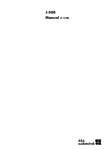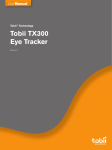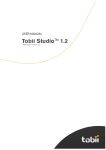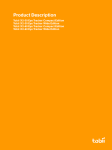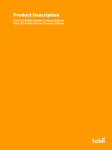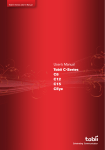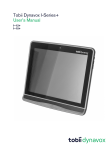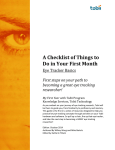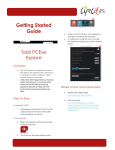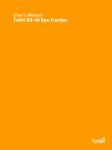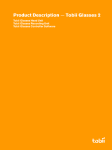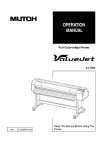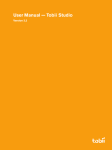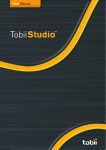Download Tobii T60 XL Eye Tracker
Transcript
Product Description Tobii® Technology Tobii T60 XL Eye Tracker Revision 1 3 Product Description Tobii T60 XL Eye Tracker Tobii® Technology Tobii T60 XL Eye Tracker Table of Contents • • • Introduction 4 Overview 4 Application areas 4 • • • • Advantages of the Tobii Eye Trackers 5 Plug-and-Play 5 Excellent tracking quality 5 Natural user environment 6 • • • • Technical Specifications 7 Tobii T series Eye Trackers - T60 XL 7 Glossary - technical specifications 8 Eye tracker data output 9 • • • • • Eye Tracking Setups 11 Single screen setup 11 Local Live Viewer 12 Remote Live Viewer 12 Minimum system recommendations 13 • • • • On Accessories & Related Products 14 Hardware 14 Software 14 Tobii Studio™ Gaze Analysis Software 14 Declaration of Conformity This equipment has been tested and found to comply with the limits for a Class B digital device, pursuant to part 15 of the FCC Rules and EMC directive 89/336/EEC. The product also conforms with the directive 73/23/EEC for low voltage. All Tobii eye trackers are CE-marked, indicating conformity with the essential health and safety requirements set out in European Directives. The Tobii Eye Trackers are for use in office and home environments. Product Description for Tobii T60XL Eye Tracker This document contains information proprietary to Tobii Technology AB . The contents are confidential and any disclosure to persons other than officers, employees, agents or subcontractors of the owner or licensee of this document, without the prior written consent of Tobii Technology AB, is strictly prohibited. No part of this publication may be reproduced, stored in retrieval system, or transmitted in any form or by any means, electronic or mechanical, including photocopying and recording, without the prior consent of the copyright holder. Revision 1.0, March 2009 Tobii Technology AB reserves the right to change the content of this manual without prior notice. Changes due to typographical errors, innacuracies or modifications in programs and/or equipment might be implemented at any time. Please check the Tobii web site www.tobii.com for updated versions of this document. All rights reserved. © Tobii Technology AB Product Description 4 Tobii T60 XL Eye Tracker Introduction Overview The new Tobii T60 XL is the only widescreen Eye Tracker for large stimulus display. Market researchers, usability professionals and scientific researchers can for the first time conduct widescreen eye tracking using large stimuli that actually become readable. The Tobii T60 XL is integrated into a high-resolution 24” TFT wide screen monitor. New technical advancements offer high-quality tracking over wide-screen gaze angles. High screen resolution and the possibility to position respondents close to the screen, allow for studying small details and peripheral vision. This document describes the features and functionality of the following products: • Tobii T60 XL Eye Tracker Application areas Market researchers can easily test print ads in the context of a magazine and measure the attention they attract relative to other competing ads and editorial text. In the scientific community, infant researchers can automatically measure preferential looking and vision researchers can use eye tracking in peripheral vision research. Examples of applications where Tobii eye trackers are clearly suitable are: • • • • • • • • • • • Studies of store shelves, packaging and virtual shopping environments Web/TV/print advertising testing Web and software usability studies Studies of reading and dyslexia Studies of infants and children Psychological studies Visual perception research Low vision studies Human factors research Eye based computer interaction and much more... Basic Operating Principles During tracking, the Tobii eye tracker uses near infrared diodes to generate reflection patterns on the corneas of the user’s eyes. These reflection patterns, together with other visual information about the person are collected by image sensors. Sophisticated image processing algorithms identify relevant features, including the eyes and the corneal reflection patterns. Complex mathematics is used to calculate the threedimensional position in space of each eyeball, and finally the gaze point on the screen; that is, where the user is looking. 5 Tobii T60 XL Eye Tracker Advantages of the Tobii Eye Trackers Plug-and-Play 100% automatic tracking The quick and easy setup procedure makes Tobii eye trackers an extremely time saving and cost efficient platform for eye tracking studies. No manual adjustments are required and no additional software needs to be installed. No highly trained operator needs to be present during testing. Works with standard computers No requirements for specialized hardware so that most desktop and laptop computers can be used. This simplifies setup and installation and enables highly portable solutions. Please note that some software applications used with Tobii eye trackers, such as Tobii Studio™, might require a computer with high performance to manage heavy media processing. Very quick and fully automatic calibration procedure The calibration procedure involves having the system display a number of points on the screen. This may involve as few as only two calibration points, but will still yield high accuracy across the entire tracking range. The calibration also uses automatic filters to select good data points. All of this enables very simple and quick calibrations, even on difficult subjects such as infants and lowvision subjects. Powerful and easily managed programming interfaces and application software The Tobii T/X Series provides easy to use and powerful programming interfaces using the Tobii Software Development Kit (SDK). Among other things, the kit provides high-level COM interfaces with tools for simple development of custom applications. Several software packages support Tobii eye trackers, including Tobii Studio™ analysis software, E-Prime experimental software, and EyeTools usability solution. Excellent tracking quality Exceptional tracking ability Tobii eye trackers track eye gaze of virtually everyone, regardless of ethnic origin, age, or glasses/contacts. This eliminates disappointing results from not being able to track a certain individual and enables high efficiency in large studies. A very high tolerance to varying light conditions, with automatic optimization for dark and bright pupil tracking also contributes to the outstanding tracking quality. Very high accuracy Extraordinary high accuracy provides reliable and precise results about the gaze position of the user. Excellent compensation for head movements and long-time drift effects also allow for a truly natural user environment. Effective binocular tracking Tobii eye trackers track both eyes simultaneously and automatically determines which eye is left and which is right regardless of head pose and blinking. Binocular tracking enables more robust tolerance to head motion since tracking continues even if one eye is hidden from the field of view of the tracker. It also makes calibrations last longer, as parts of long-time drift effects are inversely symmetrical between the eyes and can be averaged out. Validity measures The eye trackers provide a built-in, real-time tracking status meter as well as numerical validity measures for each gaze data point, which indicates the correctness of the data recorded. Being able to verify the validity of each data point provides the basis for filtering out corrupt data points, which ensures quality data. Product Description 6 Tobii T60 XL Eye Tracker Natural User Environment Freedom of head movement The eye trackers tolerate both large and rapid head movement—enough to provide an entirely unrestrained user experience. Head movements within the range of the tracking box are nearly perfectly compensated for. Tracking is resumed instantly when the user moves back into the tracking box. This ensures a completely natural and relaxing environment for the subject and provides the most realistic responses to different stimuli. As head movement is also very difficult to restrain for longer periods of time, the excellent head motion compensation of the Tobii trackers allows for unsurpassed tracking quality over long recording sessions. Integrated hardware All hardware, including user camera and speakers, is integrated into the slim casing of a TFT display. The eye tracking technology is practically unnoticeable since no sensors or other hardware elements are visible to distract the user. Long-lasting calibrations Excellent head motion compensation, and other means of drift compensation are obtained due to the sensors being fixed relative to the tracking plane, which allows for long-lasting calibrations. A user only needs to calibrate once and can reuse this calibration over and over again. Long-lasting calibrations allow for a natural user environment as the user can move around and even go away and come back without recalibrating. On many other trackers calibration quality deteriorates after only a few minutes, and constant recalibrations are therefore required on such systems. 7 Tobii T60 XL Eye Tracker Technical Specifications Mechanical measurements 573 mm Tobii T Series Eye Tracker Model T60 XL Data rate 60 Hz Head movement box Tracking distance 44 x 22 cm at 70 cm 50-80 cm Head movement error typical 0.2 degrees Accuracy typical 0.5 degrees Drift typical 0.1 degrees Spatial resolution typical 0.35 degrees Max gaze angles 42 degrees Top head-motion speed Latency Time to tracking recovery 25 cm/second maximum 33 ms typical 300 ms Weight (excluding case) ~ 13 kg / 29 lbs Eye tracking technique both bright and dark pupil tracking Eye tracking server Screen size Screen resolution (Max) Display colors Embedded 24” TFT 1080p (1920 x 1200 pixels) 16.7 M (true 8-bit) 579 mm Vertical sync frequency Horizontal sync frequency TFT response time User camera Speakers Connectors 46-63 Hz 69-78.5 kHz 4 ms Built in, frame rate 640 x 480@ 30 fps Built in, 2 x 4W power LAN, VGA, DVI-S, Power, User Camera and Audio 281 mm Average values over the screen measured at a distance of 63 cm in a controlled office environment. Product Description 8 Tobii T60 XL Eye Tracker Glossary - technical specifications Data rate Number of sampled gaze points per second. The Tobii T/X Series has a stable data-rate of 60 Hz (T60/X60/XLT60 Eye Trackers) or 120 Hz (T120/X120 Eye Trackers); that is 60 or 120 gaze data points per second are collected for each eye. Head movement box Measures the box (height × width in cm) where at least one of the eyes is within the field of view of the eye tracker (the present value was measured at 70 cm distance from the sensor). Tracking distance The distances to the sensor within which the eye tracker is able to detect at least one of the eyes. Head movement error Decrease of accuracy at the edges of the eye-tracking box as compared to the centre where the calibration was done. This includes head translations sideways as well as movement back and forth and up and down. The value is an average of the two types of translations. Accuracy The typical difference between the Measured Gaze Direction and the Actual Gaze Direction at different parts of the screen for a person positioned at the centre of the eye tracking box. This does not include drift effects and compensation errors from larger head movements. The accuracy of the Tobii eye trackers varies depending on external conditions such as lighting, quality of the calibrations, and individual eye characteristics. Drift Change in accuracy due to change in lighting. The specified value relates to complete inversion of screen color, e.g from black to white without recalibration in between. Spatial resolution The term “spatial resolution”, or “noise”, denotes the frame-to-frame variation of the measured gaze point. Max gaze angles Maximum gaze angle that the eye tracker can detect at least one pupil. The angle is calculated from the centre of the sensor. Top head-motion speed The maximum speed that a user can move the head at which the eye tracker is able to still find at least one pupil. Latency Is calculated from the time when an image was shot to when a valid gaze point is delivered to an eye tracking application there is a certain delay. This delay is caused both by sensor hardware and by the computation of the eye tracking software algorithms. Since the timestamp is set at exposure, such delay does not affect the accuracy of the timestamp. Time to tracking recovery An eye tracker working in a natural user environment often loses track of the eyes of the user, for example, when the user is blinking, looking down to type, or when the user completely turns away from the tracker. Eye tracking technique The Tobii Eye Trackers use two different techniques to determine eye position: 1. Bright pupil eye tracking, where an illuminator is placed close to the optical axis of the imaging device, and causes the pupil to appear lit up (this is the same phenomenon that causes red eyes in photos). And 2. Dark pupil eye tracking where the illuminator is placed away from the optical axis causing the pupil to appear black. Eye tracking server Gaze data calculations are performed by firmware embedded in the eye tracker. Different applications can be connected as clients to the eye tracker system over a LAN connector to gather eye gaze data and other data in realtime and to perform calibrations and other actions. 9 Tobii T60 XL Eye Tracker Eye tracker data output Different applications can be connected as clients to the eye tracker system over TCP/IP (LAN connector) to gather eye gaze data in real-time and to perform calibrations (and other actions). Examples of applications that can be used together with the eye tracker include the Tobii StudioTM analysis software, third party analysis products such as E-Prime, or your own custom written software for analysis, gazecontingent applications, or eye control applications. For more information on how to create your own applications, please refer to the Tobii Software Development Kit (SDK) product description. Below you can find a list of all data that can be accessed through the output of the eye tracker. In Tobii StudioTM analysis software this data can be accessed through a Raw data text export function, and easily imported into a spreadsheet for further analysis. Timestamp Timestamp in milliseconds for when the gaze data was collected Gaze PointXLeft Horizontal screen position of the gaze point for the left eye GazePointYLeft Vertical screen position of the gaze point for the left eye CamXLeft Horizontal location of the left pupil in the camera image (0 is left edge, 1 is right edge) CamYLeft Vertical location of the left pupil in the camera image (0 is top, 1 is bottom) DistanceLeft Distance from the eye tracker to the left eye. The distance is given in mm on a straight axis right out from the eye tracker plane PupilLeft Size of the pupil (left eye) in mm. The distance and pupil size measures are calculated to be as close to real values as possible. However, individual differences in the eyes of subjects and the strength of glasses/contact lenses will cause errors in these values. The measures still reflect changes in head position and pupil size accurately. ValidityLeft Validity of the gaze data. The validity is 0 if the eye is found and the tracking quality good. If the eye cannot be found by the eye tracker the validity code will be 4. Read more under the Validity codes section further down Gaze PointXRight The horizontal screen position of the gaze point for the right eye GazePointYRight Vertical screen position of the gaze point for the right eye CamXRight Horizontal location of the right pupil in the camera image (0 is left edge, 1 is right edge) CamYRight Vertical location of the right pupil in the camera image (0 is top, 1 is bottom) DistanceRight Distance from the eye tracker to the right eye. The distance is given in mm on a straight axis right out from the eye tracker plane PupilRight Size of the pupil (right eye) in mm. The distance and pupil size measures are calculated to be as close to real values as possible. However, individual differences in the eyes of subjects and the strength of glasses/contact lenses will cause errors in these values. However, the measures still reflect changes in head position and pupil size accurately ValidityRight Validity of the gaze data. The validity is 0 if the eye is found and the tracking quality good. If the eye cannot be found by the eye tracker the validity code will be 4. The value is for the right eye. Read more under the Validity codes section further down Additional data available in the Tobii Studio Raw Data Export DateTimeStamp Timestamp recalculated using the computer date time, shown in hours, minutes, seconds and milliseconds (hh:mm:ss:ms) DateTimeStampStartOffset Timestamp converted into hh:mm:ss format. The start time for the recording is also shown in the Replay and Visualization views in Tobii Studio if the option Show Date is selected in the Recordings field. Number Timestamps in numbered order FixationIndex Indexes for the fixation points (values correspond to the order of the fixation). Product Description 10 Tobii T60 XL Eye Tracker GazePointX Gaze PointX can be the horizontal screen position for either eye or the average for both eyes. The value to show here is specified in Tobii Studio. This value is also used for the fixation definition. GazePointY GazePointY can be the horizontal screen position for either eye or the average for both eyes. The value to show here is specified in Tobii Studio. This value is also used for the fixation definition. Event Events, automatic and logged, will show up under Events. The automatic events are start and end events for the different media, mouse clicks and key presses. The automatic events are listed in the event table under Event Key and Data. The logged events are the manually logged events entered either in the replay view or from the remote logger EventKey Unique event key is shown for different key presses. Data1 Data field for the event. The contents of this field vary depending on what type of event this is. Data2 Data field for the event. The contents of this field vary depending on what type of event this is. Descriptor Description of the event. The contents vary depending on what type of event this is. StimuliName The file name of the media given in the setup in Tobii Studio MediaWidth Media size in pixels MediaHeight Media size in pixels MediaPosX Distance from the left side of the screen to the media on the screen given in pixels MediaPosY Distance from the top of the screen to the media on the screen given in pixels MappedFixationPointX X coordinate for the fixation point mapped to the media coordinate system, where the origin for the coordinate system is the top left corner of the image/media MappedFixationPointY Y coordinate for the fixation point mapped to the media coordinate system, where the origin for the coordinate system is the top left corner of the image/media FixationDuration Fixation duration. The time in milliseconds that a fixation lasts AoiIds ID number for the AOI, usually a counter starting at zero for the first AOI AoiNames Name of the AOI or AOIs if fixations on multiple AOIs are to be written on the same row WebGroupImage Filename of the image file that is used to visualize the web group MappedGazeDataPointX X coordinate for the raw gaze data point mapped to the media coordinate system where the origin for the coordinate system is the top left corner of the image/media MappedGazeDataPointY Y coordinate for the raw gaze data point mapped to the media coordinate system where the origin for the coordinate system is the top left corner of the image/media MicroSecondTimestamp Timestamp for this export row in microseconds ValidityCodes Validity code for each data point. This code is is based on whether the system is able to identify correctly both eyes. It is recommended that the validity codes should always be used for data filtering, to remove data points that are obviously incorrect. 11 Tobii T60 XL Eye Tracker Eye Tracking Setups: The following chapters describe a number of recommended setup configurations which are suitable for different types of studies. Your particular needs may of course differ from these standard configurations, but they should give valuable insights in any event. More detailed information is available in the Eye Tracker User Manual delivered with the product. For specific information about custom configurations, or detail questions on the system configurations, please contact your Tobii sales representative, or Tobii technical support at [email protected]. Single screen setup This basic setup is the simplest setup when using on screen stimuli, such as images, movies, web or screen for advertising & usability testing, psychology research, reading research, etc. The pictures below illustrate the single screen setup with the two eye tracker connection alternatives using a USB-LAN adapter and a network connection. To get a portable lab replace the computer in the setup drawing with a laptop or shuttle computer. Option 1 - The eye tracker is connected via a USB-LAN adapter. Option 2 - The eye tracker is connected via a local network. Product Description 12 Tobii T60 XL Eye Tracker Local Live Viewer This setup requires Tobii Studio Professional or Enterprise version. The setup below is used when the test is to be supervised from a screen next to the eye tracker setup. This test setup is suitable when using on screen stimuli, such as images, movies, web or screen for advertising & usability testing, psychology research, reading research etc. In a lot of studies it is important to see the participant’s reactions and record the conversation between test leader and test participant as well as using think-aloud. The setup below includes the user camera and user sound. Both the user camera and the user audio are optional. An alternative to using the adapter in the setup drawing is to connect the eye tracker to a local network, see more under the single screen setup option. To get a portable lab replace the computer in the setup drawing with a laptop or shuttle computer. Note: The eye tracker can be connected directly to the Network instead of using the USB-LAN Adapter. See the single screen setup for more information. Remote Live Viewer This setup requires Tobii Studio Enterprise version. This setup is used when the test should be supervised and/or controlled from one or more remote stations. It can be a computer in the next room where a supervisor is sitting and a computer connected to a screen for remote viewing for customers etc. This test setup is suitable when using on screen stimuli, such as images, movies, web or screen for advertising & usability testing, psychology research, reading research etc. This setup includes the user camera and user sound. Both the user camera and the user audio are optional. An alternative to using the adapter in the setup drawing is to connect the eye tracker to a local network, see more under the single screen setup option. To get a portable lab replace the computer in the setup drawing with a laptop or shuttle computer. For Tobii Studio more than one remote viewer can take part of the testing. 13 Tobii T60 XL Eye Tracker Minimum System Recommendations For information on the Minimum System Recommendations for the Tobii T60 XL please refer to the latest System Recommendations document available from your Tobii sales representative or Tobii technical support (at [email protected]). Product Description 14 Tobii T60 XL Eye Tracker Accessories & Related Products: Hardware All eye trackers are shipped with sturdy cases that can also be used for subsequent transportation. The Tobii T60XL Eye Tracker cases are by default shipped with wheels and a foldout handle for easier transportation. A monitor arm for Tobii T60XL Eye Tracker can be used for flexible positioning of the eye tracker relative to the user. The arm can be provided either with a wall mount or a desk mount. For more detailed information visit www.tobii.com or enquire your local sales representative. Software Tobii Software Development Kit (SDK) The Tobii SDK enables the development of application software for controlling and retrieving data from the Tobii Eye Trackers. This is useful for highly customized experimental routines as well as many varieties of interaction applications based on eye tracking. The SDK provides interfaces on different levels, which are suitable for different kinds of applications – ranging from low level interfaces with high level of customization, to high level interfaces which require a minimum of programming effort. Well documented code samples provide a straight-forward introduction to the functionality ofthe SDK. The SDK aims to target developers that do not necessarily need a lot of programming experience. Just the basics. Especially, if the Microsoft Visual Basic 6.0 programming language is used and the included samples are walked through, it should be fairly easy to develop an application retrieving gaze data. Tobii Studio™ analysis software Provides sophisticated analysis tools for usability tests, psychology studies, and market research. For further information, please refer to the Tobii Studio™ product description. A short overview is also provided below. Integration package with E-Prime experimental software In-depth integration between Tobii eye trackers and E-Prime experimental software allow for complex stimulus setup. Please enquire for more information. Tobii Studio™ Gaze Analysis Software Tobii Studio™ by Tobii Technology offers a comprehensive platform for recording and analysis of eye gaze data, facilitating interpretation of human behavior, consumer responses, and physiology. It combines easy preparation of test procedures with powerful high-level data analysis and striking visualizations and statistics. Tobii Studio™ is ideal for evaluating interactive media such as websites, software, email campaigns, computer games, interactive TV, as well as print and online advertising, TV commercials, shopping shelves, and physical products. Scientific research use includes psychological response studies, infant research, reading studies, and studies of autism, ADHD and vision deficiencies. For more information about Tobii Studio™, please refer to the Tobii Studio™ product description. EMEA Tobii Technology AB Karlsrovägen 2D S-182 53 Danderyd Sweden +46 8 663 69 90 Phone +46 8 30 14 00 Fax [email protected] North America Tobii Technology, Inc. 510 N. Washington Street Suite 200 - Falls Church, VA 22046 - USA +1-703-738-1300 Phone +1-888-898-6244 Phone +1-703-738-1313 Fax [email protected] ASIA Tobii Technology, Ltd. 3-4-13 Takanawa, Minato-ku Tokyo 108-0074 Japan +81-3-5793-3316 Phone +81-3-5793-3317 Fax [email protected] central Europe Tobii Technology GmbH Niedenau 45 D-60325 Frankfurt am Main Germany +49 69 24 75 03 40 Phone +49 69 24 75 03 429 Fax [email protected] www.tobii.com
















